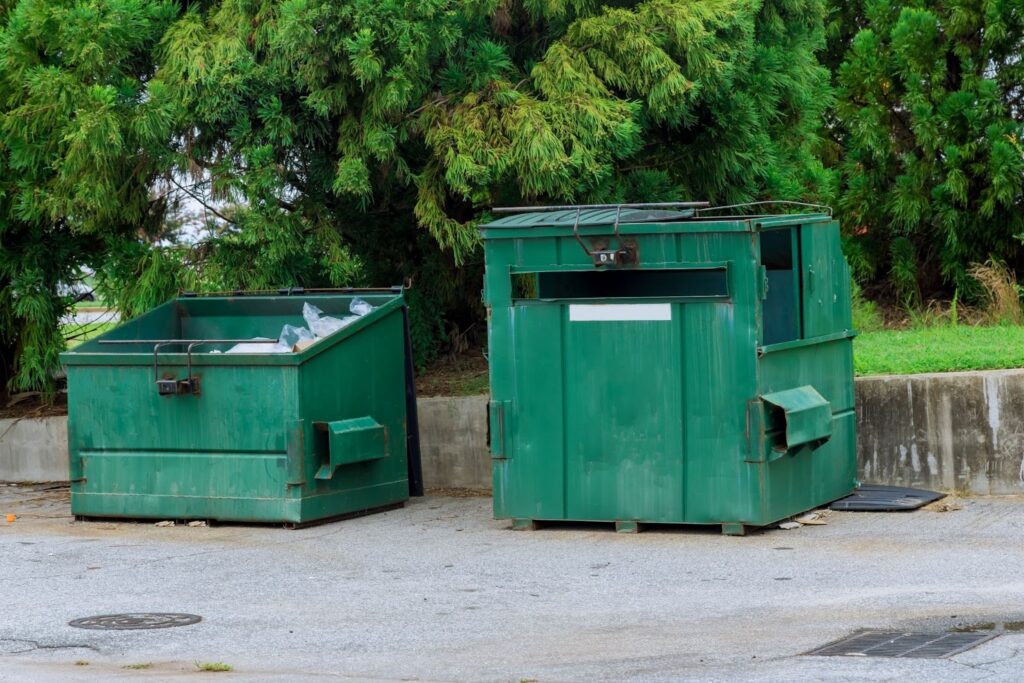A dumpster rental is more than a metal box—it’s a scheduling tool, a budget lever, and a safety measure. Choosing well means your crew isn’t tripping over debris or paying for multiple hauls. Start by defining the scope: rooms touched, materials removed, access width, and disposal rules in your city. From there, you can match volume, weight allowance, and rental window to your timeline. Good planning reduces idle labor, avoids overage fees, and keeps your demolition moving forward without interruptions.
Understanding Demolition Dumpster Rental Size and Weight Limits
Dumpster sizes are measured in cubic yards, which describe volume, not weight. Yet disposal fees, transportation limits, and landfill rules all revolve around tonnage. Dense materials—concrete, brick, tile, plaster, wet drywall—hit weight caps much faster than bulky items like cabinets and framing. Every container has a posted ton limit; exceeding it triggers per-ton overages at pickup. Understanding the difference between “fills to the top” and “weighs out early” helps you select the right capacity for the materials you’ll generate.
Picking The Right Size—10-Yard Options For A Small Demolition Dumpster Rental
Ten yards shines on targeted jobs: a small bathroom, a compact deck removal, or a shed demo with minimal concrete. The footprint fits tight driveways and alleys, reducing site disruption and protecting landscaping. Where it struggles is dense debris—two tons of tile or masonry can max the allowance before the container looks full. If your scope includes cast iron, plaster, or floor tile, a larger box with higher tonnage might be safer even if the volume seems modest.
What Typically Fits
Expect one small bath down to studs, or a modest kitchen cabinet set with countertops, plus some drywall and flooring. Heavy finishes reduce capacity quickly.
Watch The Dense Materials
A few wheelbarrows of concrete or plaster add up fast. If in doubt, step up to the next size to protect your budget from overweight charges.
A 15-Yard Demolition Dumpster Rental Offers Balance
The fifteen offers extra breathing room without a massive footprint. It suits one or two small rooms, a larger bathroom, or a partial kitchen where appliances remain. Crews like it for bungalows and narrow lots where maneuvering matters. You gain tonnage margin over a 10-yard, which is helpful if you uncover lath-and-plaster behind drywall. For many homeowners, this size strikes a balance between cost, access, and capacity.
Typical Projects
Think bath plus hallway flooring, or a small porch demo with railing and skirting. It’s also handy for roof tear-offs on modest homes.
Access Advantages
Shorter boxes are easier to place away from tree limbs and power lines. That flexibility reduces site risk and setup time.

Why 20-Yard Containers Dominate The Demolition Dumpster Rental Market
Twenty yards is the jobsite workhorse. It handles multi-room drywall, cabinets, interior doors, and non-structural framing in a mid-size space. The ton cap is usually generous enough for mixed debris as long as you’re not loading chunks of slab. Because it’s so versatile, it often delivers the lowest cost per cubic yard cleared. If your scope might grow, the 20-yard gives you room to pivot without calling for a swap-out too soon.
What It Swallows Easily
Kitchens and living areas stripped of finishes, plus a run of flooring and trim, typically fit with margin for surprises.
Mind The Weight
Add masonry or plaster and you can still hit tonnage. Keep heavy debris at the bottom and monitor as you load.
Scaling Up To 30-Yard Capacity For Larger Demolition Dumpster Rental Projects
The thirty is made for larger interiors, multiple rooms, or light structural changes. It excels with bulky items: built-ins, long runs of carpet, large sections of siding, and stacked cabinetry. Despite the bigger volume, the same weight rules apply; a few pallets of brick will still tip the scales. If your project is a whole-house interior demo without concrete removal, this size often prevents mid-week swap-outs.
Multi-Space Efficiency
Batching rooms into one container keeps momentum. Crews can stage debris and load once instead of piecemeal trips.
Clearance Considerations
You’ll need more overhead room for placement. Confirm trees, wires, and eaves won’t block the roll-off truck.
When To Use A 40-Yard Demolition Dumpster Rental For Major Jobs
Forty yards is about bulk, not boulders. It’s useful for large renovations, commercial interiors, or extensive siding removals where debris is voluminous but not dense. Load discipline is critical; if you toss masonry, you’ll blow past ton limits quickly. When used for light materials—studs, sheathing, drywall—it minimizes hauls and downtime. Make sure the site has ample turning radius and a surface that can handle the truck’s weight.
Volume Caveat
Don’t confuse air with weight. Big voids between studs and trim pieces can trick you into thinking there’s room left when the tonnage is close.
Site Logistics
Plan a straight approach and firm ground. Soft lawns, steep grades, and tight corners complicate delivery and pickup.
Matching Materials To The Right Demolition Dumpster Rental Size
Drywall and lumber consume volume but not tons, so larger boxes shine. Plaster, tile, concrete, and brick consume tons first; smaller boxes with multiple pulls may be cheaper than one overweight pickup. Asphalt shingles sit in the middle and vary by layer count and moisture. Appliances, doors, and windows are bulky but manageable if you stage and break them down where possible. Matching material type to container behavior is the secret to cost control.
Heavy vs. Light Debris
Separate heavy loads when you can. A dedicated run for masonry protects other containers from overages.
Mixed Loads and Sorting
Keeping metals separate may earn a rebate. Clean wood and cardboard are easier to recycle when not buried under plaster dust.
Preventing Overage Fees On Your Demolition Dumpster Rental
Overages are based on weight, over-the-rim loading, prohibited items, and extended rental days. Ask for the base ton allowance and the per-ton rate, then estimate using pounds per square foot for your materials. Load level with the top rail; towering piles risk unsafe transport and rejection. If you expect extra weight, request a higher ton cap up front or schedule a mid-project swap—both are cheaper than surprise fees at pickup.
Tonnage Math Matters
A small tiled bath can weigh more than a large carpeted room. Adjust your estimate by material, not just by square footage.
Load Level and Even
Keep weight centered and below the rim. Even distribution helps safe hauling and avoids delays.
Every Demolition Dumpster Rental Has Safety Rules and Restricted Items
Landfills and transfer stations reject hazardous items: liquids, paints, solvents, batteries, tires, refrigerants, and electronics in many regions. Pressure vessels like propane tanks are a hard no. Sharps and glass should be contained to protect loaders and haulers. If you’re unsure, ask your provider for a do-not-load list before work begins. Safe contents keep your project legal, prevent fines, and protect everyone on site.
Scheduling Swap-Outs and Timelines For A Demolition Dumpster Rental
High season and post-storm periods book fast, so reserve early. If your scope is phased, plan swap-outs at natural milestones—after kitchen gut, after bath tear-out, after flooring removal—so crews never stall. Confirm standard rental days, daily extension fees, and cut-off times for same-day exchanges. Clear communication keeps bins arriving on cue and prevents piles of debris from creeping across the site.
Book Ahead
A firm delivery window and a backup date protect your schedule. Busy weeks fill quickly after regional weather events.
Stage Debris Smart
Pile near the load door in manageable pieces. Fast, continuous loading shrinks labor hours and rental time.

Protecting Your Property During A Demolition Dumpster Rental
Roll-offs are heavy. Protect irrigation heads, mark septic lids, and flag low branches along the delivery route. Notify neighbors of delivery and pickup windows to avoid blocked cars or mail access. Keep the area swept; nails and screws wander farther than you think. A tidy, respectful operation avoids complaints and keeps your crew welcome on the block.
Think Runoff
Rain turns gypsum dust to paste. Keep brooms and a hose handy to prevent slick sidewalks and clogged drains.
Light The Work Zone
If you’ll load near dusk, temporary lighting reduces trips and stumbling. Safer loading is faster loading.
Estimating Demolition Dumpster Rental Volume Correctly
Visualize rooms as stacks of 3’×3’×3’ cubes—each is about a cubic yard. Count cabinets, drywall sheets, and studs by bundle to convert to yards. Add a contingency for surprises behind walls and for packaging from new materials. When in doubt, size up once rather than paying for a second haul or overweight charges. Accurate estimates produce cleaner budgets and fewer mid-project pivots.
Walk The Path
Measure doorways and turns before demo. If items need cutting to exit, they’ll pack differently in the bin.
Debris Shrinks—Then Doesn’t
Breaking down increases density quickly. Great for volume, risky for tonnage; keep an eye on both as you load.
The Right Demolition Dumpster Rental Choice
Match container size to debris behavior and access, align ton caps with the heaviest materials, and protect your site with smart placement. Build your schedule around swap-outs and city rules, and confirm what can’t go into the bin. If recycling is a goal, plan clean loads or pull high-value metals. With a few well-timed decisions, you’ll keep crews moving, costs predictable, and the jobsite safe from start to finish.
Visit our Top Dog Waste Solutions blog to learn more about the different use cases for every size of dumpster.








